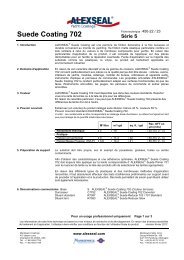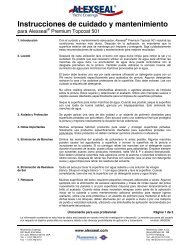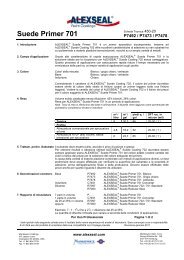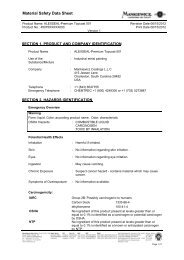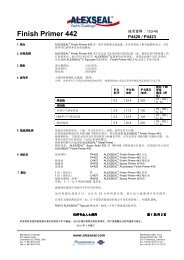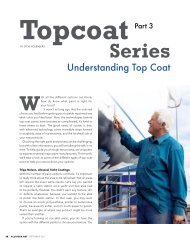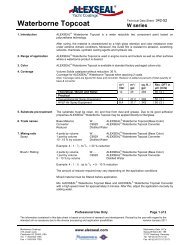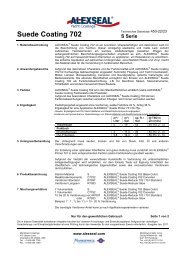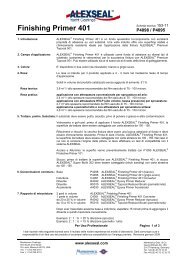Professional Application Guide - Alexseal
Professional Application Guide - Alexseal
Professional Application Guide - Alexseal
You also want an ePaper? Increase the reach of your titles
YUMPU automatically turns print PDFs into web optimized ePapers that Google loves.
Substrate Preparation & PrimingGelcoat & Fiberglass Resin SubstrateThe gelcoat substrate must be cleaned thoroughly of all surface contamination priorto sanding with ALEXSEAL ® Surface Degreaser / Dewaxer (A9091) using the “Two RagCleaning Method” starting on page 31.Additional cleaning may also be performed using a professional cleaner/degreaser or apowdered cleanser (such as Ajax ® or Comet ® ) and 3M Scotch-Brite ® pads to scrub thesurface to be painted. When rinsing the surface with clean water, the water should sheetout “break-free” – indicating a clean surface. Any breaks in the water film can indicaterelease agents and or other contamination present on the surface.All resin and gelcoat substrates must be completely cured and solvent resistant.Gelcoat substrates should be sanded with 100 - 150 grit until a surface profile of 1mil (20 - 35 microns) is achieved. After sanding, remove dust and residual debris withclean compressed air. Wipe down the surface with ALEXSEAL ® Surface Degreaser /Dewaxer (A9091).Raw resin substrates must be ground 100% dull (no shiny spots or pits) with 36 - 60grit.After sanding and grinding as required, remove dust and residual debris with cleancompressed air.Important:DO NOT use solvents to wipe or clean raw resin areas after grinding andsanding. This will soften the resin and could affect the adhesion to the paintand fairing system.Once the surface is properly prepared, you may proceed to fill and fair the surfaceas needed. If no filling and fairing is required, you may proceed to the application ofALEXSEAL ® Finish Primer 442 and/or an ALEXSEAL ® Topcoat. According to the needsof your application, please see the following sections:• “Fairing” starting on page 32• “Surfacing” on page 36• “Final Priming & Sealing” starting on page 39• “Finishing” starting on page 41Wood SubstrateIt is important to note that when applying paint to solid or composite wood substrates,there are additional concerns of moisture and temperature that cause both physicaland chemical variations in the wood. Exposed wood may expand and contract creatinggaps, fissures and imperfections, requiring additional sanding and priming beyond whatis done for other surfaces.Important:ALEXSEAL ® Premium Topcoat 501 may crack when applied over joined edgesor seams. When preparing wood surfaces that are planked or have a largenumber of seamed or joined areas, special attention should be paid to assuring thatSubstrate Preparation & Primingthese areas are adequately filled and prepared to create a uniform, sealed surface overthe wood substrate. Substrate lumber material should be fully cured and have moisturecontent of less than 15%. DO NOT use pressure treated wood, as the ALEXSEAL ®system will not adhere to this type of wood treatment.All wooden substrates must be cleaned thoroughly of surface contamination prior tosanding with ALEXSEAL ® Surface Degreaser / Dewaxer (A9091) using the “Two RagCleaning Method” starting on page 31.All wood surfaces must be completely dry, cured out and solvent resistant. Exposedwood must be initially sanded with 80 - 100 grit sandpaper. If grinding is required toremove extensive deposits or built up material, use caution to avoid marring or deeplyscratching the base wood surface.Important:DO NOT use slow evaporating solvents to wipe or clean prepared areas aftergrinding or sanding. Solvents will be absorbed by the wood and could affectadhesion to the paint or fairing system. Clean virgin denatured alcohol may be usedto remove oils from the wood that are exposed during the sanding process. Woodensurfaces should end up being sanded with 180 - 220 grit sandpaper to achieve a properprofile for priming. It is a good practice to vacuum and use clean compressed air toremove fine sawdust and residual particles immediately before applying any primer.If required, seams can be filled with a polyurethane seam-sealing compound. Allow thesealer to thoroughly cure before proceeding.Note:Polyurethane and polysulfide compounds have a certain amount of flex whichwill move with the wood and prevent cracking or deforming to a certainextent. Boats with dynamic seams may flex beyond the adhesion characteristics ofthese compounds, which can result in cracking of the ALEXSEAL ® topcoat. Be sureyou DO NOT use any silicone-based caulk or compounds in this process.Apply a sealer coat of high quality epoxy resin or ALEXSEAL ® Finish Primer 442 to sealthe wood surface. This should occur within 24 hours of the sanded wood preparation,provided that the painting facility is relatively dry and maintains low humidity to preventthe exposed wood from absorbing moisture.When sealing the wood with an epoxy resin, apply multiple coats of a high quality, clearepoxy resin per the manufacturer’s recommendations. Always wash down the curedepoxy resin surface with water before sanding and applying additional products.When sealing the wood with ALEXSEAL ® Finish Primer 442, refer to instructions in the“Technical Data Sheets” starting on page 64. The first coat of primer should bereduced 30 - 40% to allow for the sealer coat to soak into the grain. After the sealercoat has been allowed to dry overnight – but not more than 24 hours – at 25° C (77°F) apply two to three additional coats of Finish Primer 442 mixed and reduced asdescribed in the Technical Data Sheet. If more than 24 hours passes before applyingadditional coats of primer, the surface must be sanded with 180 - 220 grit sandpaper.26 ALEXSEAL ® <strong>Professional</strong> <strong>Application</strong> <strong>Guide</strong> version 0.4.3ALEXSEAL.COM > Europe: +49 0 40 75 10 30 > North America: +1 843 654 775527




